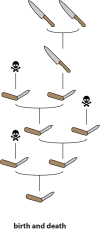How the Toxin got its Toxicity
- PMID: 33381030
- PMCID: PMC7767849
- DOI: 10.3389/fphar.2020.574925
How the Toxin got its Toxicity
Abstract
Venom systems are functional and ecological traits, typically used by one organism to subdue or deter another. A predominant subset of their constituent molecules-"toxins"-share this ecological function and are therefore molecules that mediate interactions between organisms. Such molecules have been referred to as "exochemicals." There has been debate within the field of toxinology concerning the evolutionary pathways leading to the "recruitment" of a gene product for a toxic role within venom. We review these discussions and the evidence interpreted in support of alternate pathways, along with many of the most popular models describing the origin of novel molecular functions in general. We note that such functions may arise with or without gene duplication occurring and are often the consequence of a gene product encountering a novel "environment," i.e., a range of novel partners for molecular interaction. After stressing the distinction between "activity" and "function," we describe in detail the results of a recent study which reconstructed the evolutionary history of a multigene family that has been recruited as a toxin and argue that these results indicate that a pluralistic approach to understanding the origin of novel functions is advantageous. This leads us to recommend that an expansive approach be taken to the definition of "neofunctionalization"-simply the origins of a novel molecular function by any process-and "recruitment"-the "weaponization" of a molecule via the acquisition of a toxic function in venom, by any process. Recruitment does not occur at the molecular level or even at the level of gene expression, but only when a confluence of factors results in the ecological deployment of a physiologically active molecule as a toxin. Subsequent to recruitment, the evolutionary regime of a gene family may shift into a more dynamic form of "birth-and-death." Thus, recruitment leads to a form of "downwards causation," in which a change at the ecological level at which whole organisms interact leads to a change in patterns of evolution at the genomic level.
Keywords: duplication; evolution; function; gene expression; genomics; molecule; toxin; venom.
Copyright © 2020 Jackson and Koludarov.
Conflict of interest statement
The authors declare that the research was conducted in the absence of any commercial or financial relationships that could be construed as a potential conflict of interest.
Figures






Similar articles
-
Toxinology provides multidirectional and multidimensional opportunities: A personal perspective.Toxicon X. 2020 May 11;6:100039. doi: 10.1016/j.toxcx.2020.100039. eCollection 2020 Jun. Toxicon X. 2020. PMID: 32550594 Free PMC article.
-
The Birth and Death of Toxins with Distinct Functions: A Case Study in the Sea Anemone Nematostella.Mol Biol Evol. 2019 Sep 1;36(9):2001-2012. doi: 10.1093/molbev/msz132. Mol Biol Evol. 2019. PMID: 31134275
-
Intragenome Diversity of Gene Families Encoding Toxin-like Proteins in Venomous Animals.Integr Comp Biol. 2016 Nov;56(5):938-949. doi: 10.1093/icb/icw097. Epub 2016 Aug 19. Integr Comp Biol. 2016. PMID: 27543626
-
Evolutionary Features in the Structure and Function of Bacterial Toxins.Toxins (Basel). 2019 Jan 3;11(1):15. doi: 10.3390/toxins11010015. Toxins (Basel). 2019. PMID: 30609803 Free PMC article. Review.
-
Venom evolution through gene duplications.Gene. 2012 Mar 15;496(1):1-7. doi: 10.1016/j.gene.2012.01.009. Epub 2012 Jan 18. Gene. 2012. PMID: 22285376 Review.
Cited by
-
A Short Review of the Venoms and Toxins of Spider Wasps (Hymenoptera: Pompilidae).Toxins (Basel). 2021 Oct 21;13(11):744. doi: 10.3390/toxins13110744. Toxins (Basel). 2021. PMID: 34822528 Free PMC article. Review.
-
Tracking the recruitment and evolution of snake toxins using the evolutionary context provided by the Bothrops jararaca genome.Proc Natl Acad Sci U S A. 2021 May 18;118(20):e2015159118. doi: 10.1073/pnas.2015159118. Proc Natl Acad Sci U S A. 2021. PMID: 33972420 Free PMC article.
-
The Fast and the Furriest: Investigating the Rate of Selection on Mammalian Toxins.Toxins (Basel). 2022 Dec 1;14(12):842. doi: 10.3390/toxins14120842. Toxins (Basel). 2022. PMID: 36548740 Free PMC article.
-
A Transcriptomic Approach to the Recruitment of Venom Proteins in a Marine Annelid.Toxins (Basel). 2021 Jan 28;13(2):97. doi: 10.3390/toxins13020097. Toxins (Basel). 2021. PMID: 33525375 Free PMC article.
-
Evolutionary insights into toxins diversity in Ceriantharia (Cnidaria; Anthozoa).Toxicon X. 2025 Jun 4;27:100227. doi: 10.1016/j.toxcx.2025.100227. eCollection 2025 Sep. Toxicon X. 2025. PMID: 40552252 Free PMC article.
References
LinkOut - more resources
Full Text Sources

